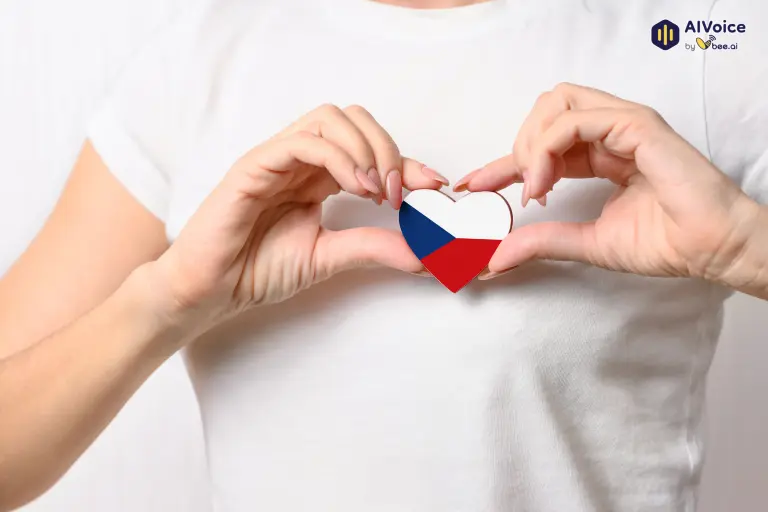Text to Speech technology for Czech is not only for automated communication, but also part of the effort to preserve the language, spread the culture and optimize the native user experience.
1. Why does Czech need TTS support?
Czech, the official language of the Czech Republic, is spoken by over 10 million people worldwide, primarily in Central Europe. It’s vital for culture, education, public administration, and daily life in regions like Prague and beyond. In the digital era, TTS ensures Czech integrates into automated systems like virtual assistants, e-learning platforms, and call centers.
Strong digital transformation demands cost-effective, flexible solutions. TTS enables this by converting text to natural speech, reducing reliance on human recordings. For a language like Czech—with complex phonetics, diacritics (e.g., č, š, ž), and stress patterns—advanced AI models preserve authenticity while making content accessible globally.
2. Practical benefits of Czech TTS
Czech TTS goes beyond basic reading, offering real-world advantages:
2.1 Enhancing Accessibility for the Elderly and Visually Impaired
TTS allows screen-free access to information, crucial for public services, healthcare apps, and news. For instance, apps can read aloud government announcements or medical instructions in natural Czech accents.
2.2 Supporting Language Learning for Foreigners and Natives
Standard pronunciation helps learners practice listening and speaking. Tools with adjustable speed aid beginners, while emotional intonation improves comprehension for advanced users.
2.3 Automating Tourism and Public Information
Attractions like Prague Castle or transport hubs use TTS for multilingual announcements, ensuring localized, accurate guidance for tourists.
2.4 Optimizing Business Costs and Content Creation
Businesses create voiceovers for ads, training, or IVR systems without studios. Small Czech firms save time and money, generating audio in minutes.
3. Outstanding features of Czech TTS technology
Modern Czech TTS leverages AI for:
- Accurate Pronunciation: Handles complex syllables, intonation, and stress (e.g., vowel length in words like “dlouhý”).
- Diverse Voices: Male/female options, accents (standard vs. regional), and tones (formal, friendly, emotional).
- Integration Flexibility: APIs for apps, chatbots, and websites; SSML for custom pauses, pitch, and emphasis.
- Customization: Speed, volume, and voice cloning for personalized experiences.
- High-Quality Output: 2025 models use deep learning for near-human speech, with contextual awareness.
| Bela |

4. Some effective Czech TTS support tools
4.1 Murf.ai
Murf is a text-to-speech platform aimed at content creators, small and medium-sized businesses, and teachers who need to create lectures with professional voices. Murf supports Czech with a variety of male/female voices that are natural, easy to listen to, and can adjust speed, pitch, and pauses.
Murf’s strength lies in its intuitive interface, allowing non-professional users to edit, insert background music, and synchronize voices with images or videos. This is an ideal choice for businesses in the Czech Republic that need to create voice-overs for marketing videos, digital lectures, or internal training materials.
4.2 ElevenLabs
ElevenLabs is considered one of the most realistic voice-generating TTS platforms today, with outstanding ability to handle emotions, intonation, and context. This platform has supported Czech voices, providing a realistic audio experience, especially suitable for high-quality applications such as dubbed movies, games, audiobooks, or smart chatbots.
One of the standout features of ElevenLabs is its voice cloning technology, which allows for the creation of personalized voices based on user-provided voice samples, including in Czech. This is a potential solution for brands that want to build their own “voice recognition” or recreate specific voices for game characters and creative products.
4.3 OpenAI Text-to-Speech (TTS)
OpenAI has expanded its TTS platform with the goal of creating near-human quality voices, thanks to modern speech synthesis models such as Whisper and new versions of TTS based on deep learning. With support for Czech, OpenAI delivers clear, natural and emotionally expressive speech, which is difficult to achieve with many conventional TTS tools.
The strength of OpenAI TTS is its ability to integrate closely with other products such as ChatGPT, Codex or the Content Synthesis API, allowing you to create not only voice readings, but also intelligent voice conversations. This opens up a wide range of applications such as Czech virtual assistants, interactive courseware, and intelligent auto-response systems.
Although still in its infancy, OpenAI TTS is a notable choice if you are looking for a modern, flexible, and fully AI-integrated Czech voice platform.
4.4 Vbee AIVoice
Vbee – a TTS platform from Vietnam is expanding its multilingual capabilities, in which Czech may be on the roadmap for enterprise support. The advantage lies in the ability to create personalized brand voices, something that large tools find difficult to customize deeply.

Vbee Text to speech Český generators provide a realistic and immersive experience with emotive voices. Leveraging AI artificial intelligence technology, Vbee excels at generating lifelike and emotionally resonant Czech voiceovers that closely mimic real human speech. The conversion of text into Czech audio is a swift process, taking only a few minutes. No longer will you require manual recording or spend time on traditional dubbing methods.
Vbee AIVoice simplifies the process of transforming text into realistic audio and video files. Begin with plain Czech text for our free text-to-speech service. Pick from our selection of male and female voices with a Czech accent, and proceed to convert the text into audio.
Vbee facilitates the seamless creation of lifelike audio using cutting-edge voice generation technology from text.
Here’s the process:
- Start with plain Czech text.
- Choose our text to speech Czech male and female voices.
- Convert the text to Czech speech.
5. Applications of TTS in Daily Life in the Czech Republic
Text-to-Speech (TTS) technology is not just for high-tech applications but is also becoming a part of everyday life for Czechs. Here are ways TTS is transforming how people in the Czech Republic interact with technology:
- Public Transportation: In major cities like Prague and Brno, TTS is used in announcement systems at train stations, airports, or buses, delivering information in standard Czech and other languages. This helps both locals and tourists navigate with ease.
- Healthcare: Hospitals and clinics use TTS to read aloud medication instructions, appointment details, or health information, making it easier for the elderly and visually impaired to access critical information without reading text.
- E-commerce: Czech online retailers, such as Alza.cz, integrate TTS into chatbots to vocalize product descriptions or shopping guides, creating a more user-friendly experience for older customers or those multitasking.
- Personal Entertainment: Czechs use TTS to listen to audiobooks, podcasts, or even convert blog posts into audio for consumption while driving or doing household chores, catering to modern, busy lifestyles.
- Real-Life Story: A visually impaired student in Brno used TTS to listen to study materials from Masaryk University, enabling her to complete her coursework independently without relying on human readers.
6. FAQs about Czech TTS Technology
6.1 Does Czech TTS Sound Like a Native Speaker?
Yes. Platforms like ElevenLabs and ReadSpeaker use deep learning for native-like intonation and stress.
6.2 Can I Use It for Videos or Podcasts?
Absolutely. Export to MP3/WAV for easy integration into content creation tools.
6.3 Are These Platforms Easy to Use?
Most have browser-based interfaces with previews – no coding needed.
6.4 Does It Support Emotion and Adjustments?
Yes, including speed, pitch, and expressive tones via SSML.
6.5 Can I Integrate It into Apps?
Yes, via APIs for websites, mobile apps, or systems.
Speech technology not only makes communication more efficient, but also reasserts the value of less-popular languages like Czech on the global digital map. Whether in business communication, public services, or education, Text to Speech Czech offers a civilized, modern, and native-friendly approach – while also expanding access for foreigners living, working, or traveling in the Czech Republic.

